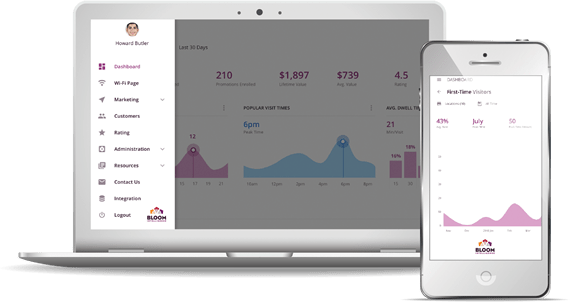When executing effective brick-and-mortar offline marketing campaigns, WiFi analytics can be the missing link that marketers have been searching for. This is especially the case for restaurants, coffee shops and other retail locations.
 Marketers know that to succeed in today’s marketplace, campaigns must be built upon accurate, comprehensive data about your customers. The problem for most marketers lies in exactly how to gather the necessary data and then arrange it into useable customer profiles.
Marketers know that to succeed in today’s marketplace, campaigns must be built upon accurate, comprehensive data about your customers. The problem for most marketers lies in exactly how to gather the necessary data and then arrange it into useable customer profiles.
Gathering information about customers in your demographic groups can be challenging and expensive, but it doesn’t have to be! (more on that below)
It is, however, extremely important because it can help you identify where the highest-potential opportunities are in your market and help you build creative strategies and targeted WiFi marketing campaigns. The issue for many companies is finding this information in a safe, secure, unobtrusive, and inexpensive way.
Gathering the Data
There are many websites that publish demographic and psychographic data, such as the American Fact Finder from the U.S. Census Bureau, or the Consumer Expenditure Survey found on the U.S. Bureau of Labor Statistics website. But these types of sources only provide overall population demographics — not necessarily those who are in your target audience groups.
So how do you find this data for those who are most likely to be your actual customers? You get it from your actual customers through market research. Market research companies, however, can be very expensive. According to market research company CSR, a 90-minute focus group of 8 consumers can cost nearly $6,000, and personal interviews can cost around $325 per person. According to another market research company Hosted Survey, the cost for completing 200 phone surveys can vary between $5,000 and $15,000, and mail surveys cost between $5,000 and $7,000.
You must also realize that the data you get from these strategies is simply a snapshot in time of how consumers felt at the time of the survey. If you ever want updated data, you’ll have to keep purchasing it.
Do It Yourself
You can ask your customers to participate in surveys and questionnaires directly, without the help of a market research company. This will give you that same detailed insight into your customer base and allow you to build customer profiles for these consumers. While this is much less expensive than hiring a company, it is extremely time consuming, potentially off-putting for your customers, and the data collected must be processed into a useable format.

While this gives you a great look into your customer base, you’ll still only be seeing an extremely small sample size. This will decrease the accuracy of the data and you could still end up wasting money in your marketing efforts by targeting the wrong people with the wrong message.
Another way to gather customer data is to obtain the information about those who are visiting your website. This can easily be done using a tool such as Google Analytics. You can also gather information from people when they download your company’s mobile app or sign up for your loyalty program. But this is still just a very small portion of your customer base, and the specific data points you can collect from these sources can be limited.
Fortunately, there is a much less expensive way to gather true market data, in real time, from a large sample size of your actual customers.
WiFi Data Collection: WiFi Analytics
A powerful way to get comprehensive data from a very large sample size of your actual customer base is by using WiFi technology. This method uses your WiFi access points to “watch” customers at your physical location, collecting anonymous data and measuring their behavior without them having to log into your WiFi.
If they do log into your WiFi you can begin gathering even more of the demographic and behavioral information necessary for successful marketing campaigns. Your WiFi analytics and marketing solution will remember each visitor, based on the unique ID of their mobile device, and the data it has collected about them. This way you can not only track things like age, gender, dwell time and visit time, but you can track things like customer repeat rates, first time visitor return rates, churn rates, and more.
This also opens up the door to a very effective strategy. Now physical locations, such as restaurants, cafes and retail shops, can passively collect meaningful, deep customer data and store it in a customer hub. The data can come from a variety of sources – WiFi sensors, BLE sensors, WiFi landing pages, online sources, social media channels, and Point of Sales systems.

Your customer hub should be able to easily and permanently store all of the data and allow you to see a graphical representation or table of all of the data.
Now you can learn who your customers really are, and you’ll be able to create much more effective data-driven marketing campaigns to your newfound customer segments. Just imagine the amazing potential your marketing efforts will have when you have access to this kind of valuable and detailed information.
It is all done for you, behind the scenes, and laid out in an easy-to-understand graphical dashboard. You can start building detailed customer profiles without lifting a finger. You’ll be able to start defining your customer segments and ideal customers and begin your marketing and promotion to each of those segments immediately.
{{cta(‘d916771f-4aa5-4869-85d2-2e938fa36500’)}}




.svg)